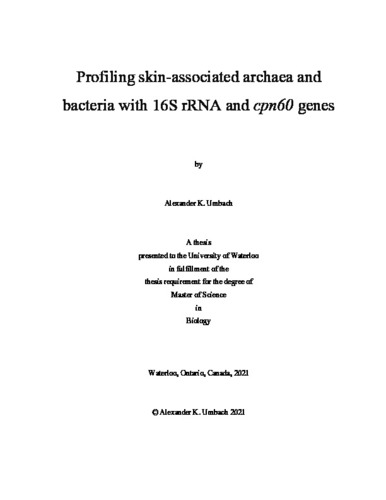| dc.description.abstract | As the largest organ of the mammalian body, skin is associated with commensal microorganisms that impact host health. Characterizing host-microbe associations is critical to our understanding of skin health, function, and disease, and the potential co-evolutionary relationships that have occurred throughout mammalian and prokaryotic evolution. The research within this thesis focused on profiling the bacteria and archaea that inhabit mammalian skin using two phylogenetic marker genes: cpn60 and 16S rRNA. The cpn60 gene was applied to mammalian skin swab samples to provide increased taxonomic resolution for microbial populations on mammalian skin. Datasets previously generated using the 16S rRNA gene were included to assess archaeal populations associated with the skin and skin-associated surfaces.
Previous research into the mammalian skin microbiome using the 16S rRNA gene identified evidence for phylosymbiosis within the Perissodactyla and Artiodactyla, as well as highlighted core taxa common to all sampled mammalian skin. The increased taxonomic resolution provided by the cpn60 gene has the potential to reveal additional co-evolutionary patterns and can more thoroughly probe specific populations of the mammalian skin microbiome. Chapter 2 of this thesis describes a newly generated cpn60 gene dataset sourced from the mammalian skin microbiome of Carnivora, Perissodactyla, Artiodactyla, and Primate hosts. Significant patterns of phylosymbiosis for Artiodactyla and Perissodactyla were confirmed when using weighted (p = 4.43x10-2) and unweighted (p = 4.36x10-2) UniFrac metrics, which are observations not made previously with a comparable 16S rRNA gene dataset. Using the cpn60 gene, specific Staphylococcaceae communities were successfully delimited from their genus classifications, with improved species-level resolution for Macrococcus, Staphylococcus, and Salinicoccus, compared to the 16S rRNA gene dataset. Additionally, Jeotgalicoccus halophilus was detected broadly within mammalian skin microbiomes, representing a first report of widescale association of this species with mammalian skin. These results demonstrate associations between mammalian hosts and skin-associated taxa warrants further investigation. Future amplicon-based skin microbiome studies focusing on host-microbe interactions would benefit from continued use of the cpn60 gene given the increased taxonomic resolution that it provides.
Limited skin-related archaea research has not yet allowed for a consensus on the prevalence of skin-associated archaea. Recent studies suggest that archaea are consistently detected and relatively abundant on human skin, with skin “archaeomes” dominated by putative ammonia oxidizers of the Nitrososphaeria class (Thermoproteota phylum - formerly Thaumarchaeota). Chapter 3 evaluated new and existing 16S rRNA gene sequence data sourced from mammalian skin and skin-associated surfaces, generated with two commonly used universal prokaryotic primers sets, to assess archaeal prevalence, relative abundance, and taxonomic distributions. Archaeal 16S rRNA gene sequences were detected in only 17.5% of 1,688 sample high-throughput sequence data, with most of the archaea-positive samples associated with non-human mammalian skin. Only 5.9% of human-associated skin sample datasets contained sequences affiliated with archaeal 16S rRNA genes. When detected, the relative abundance of sequences affiliated with archaeal ASVs was less than 1% for most mammalian skin samples and did not exceed 2% for any samples. Although several computer keyboard microbial profiles were dominated by Nitrososphaeria sequences, all other skin microbiome datasets tested were primarily composed of sequences affiliated with Methanobacteriota and Halobacteriota phyla. Our findings revise downwards recent estimates of human skin archaeal distributions and relative abundances, especially those affiliated with the Nitrososphaeria, reflecting a limited and infrequent archaeal presence within the mammalian skin microbiome.
This work provides insight in the microbial communities of mammalian skin-associated bacteria and archaea, their relationships with mammalian hosts. Increased sequencing depth and mammalian host representation could reveal additional co-evolutionary patterns, and the species-level resolution provided by the cpn60 gene could be used to target additional microbial populations of interest. Likewise, additional research into the mammalian skin archaeome would benefit from further comparisons of universal and archaea-specific primers and help elucidate potential differences in abundance and distribution caused by regionality. | en |

